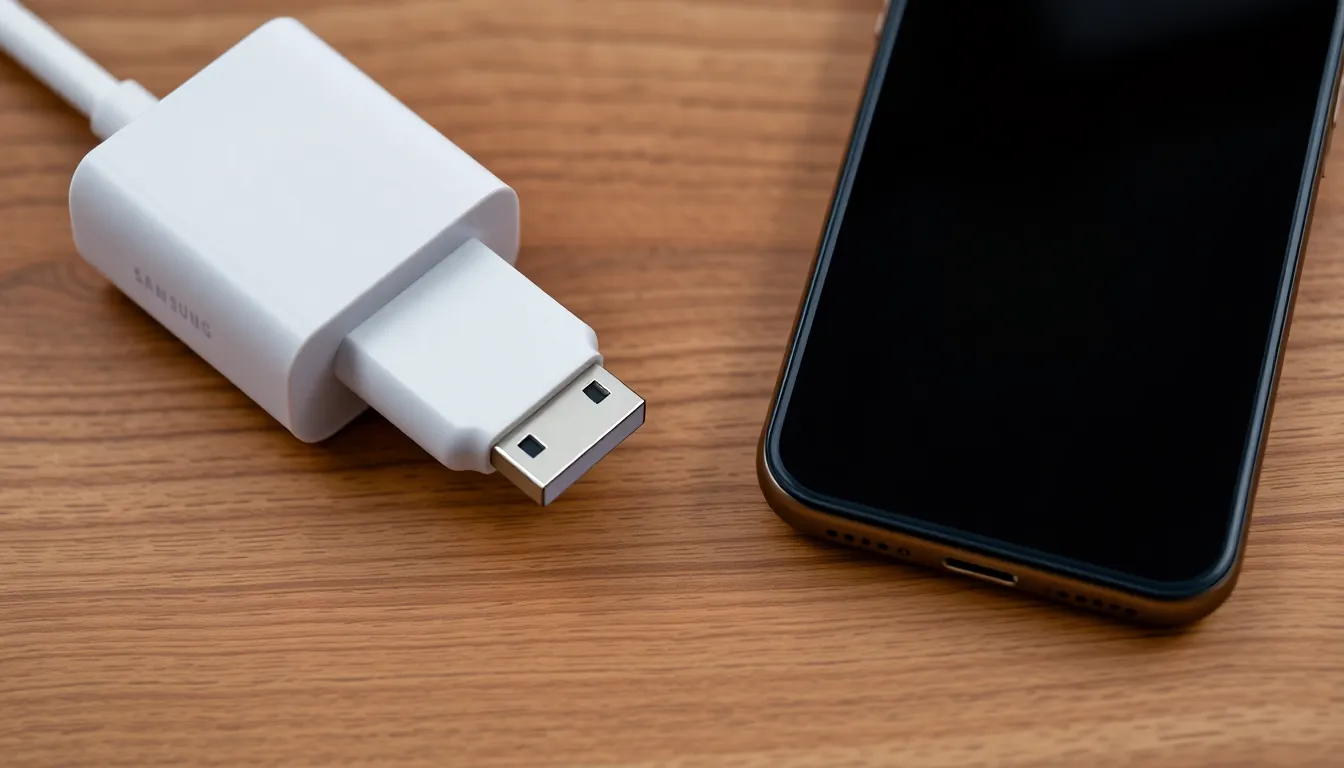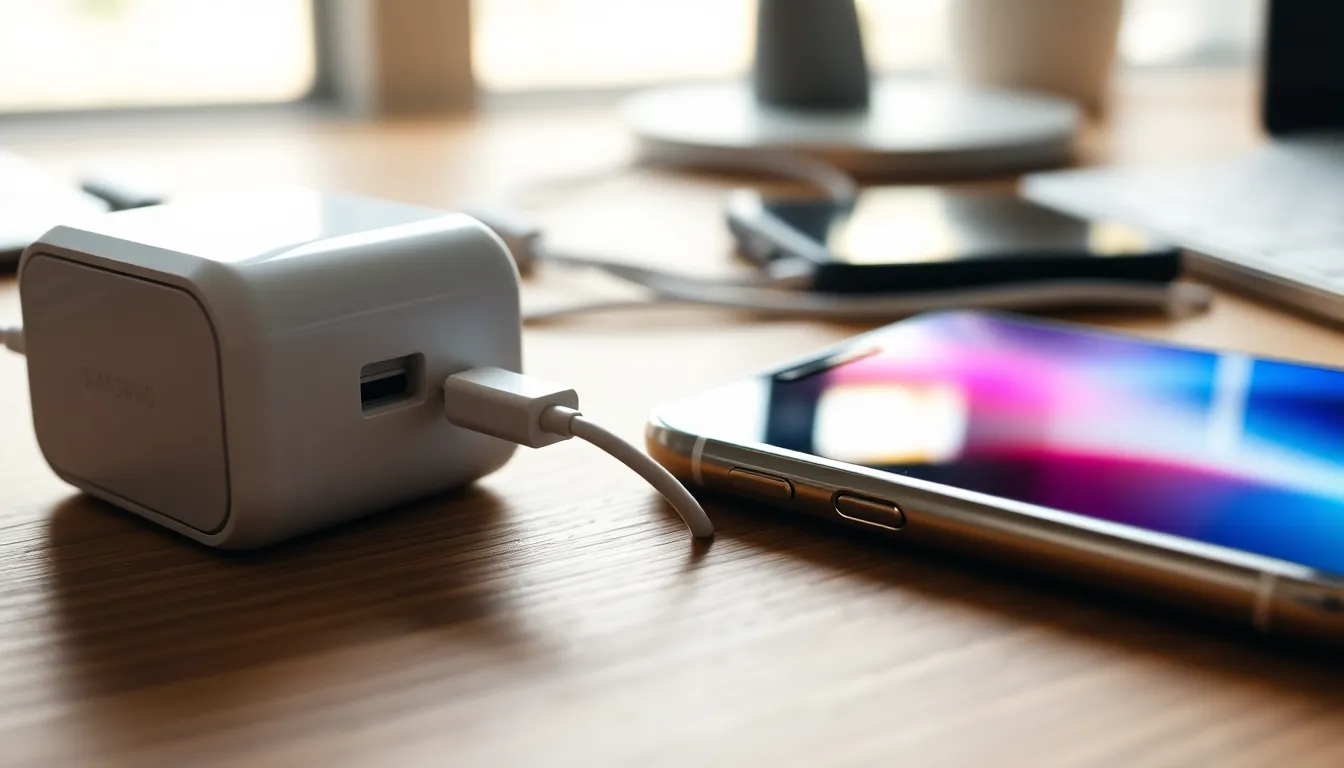Table of Contents
ToggleIn a world where chargers seem to multiply like rabbits, the question often arises: can you use a Samsung charger for an iPhone? It’s a dilemma that sparks curiosity and perhaps a little panic in the hearts of tech enthusiasts. After all, who hasn’t found themselves in a tight spot, desperately searching for a power source while their beloved device gasps for battery life?
Overview of Charger Compatibility
Samsung chargers and iPhone chargers are designed with different specifications. Different brands use distinct technologies regarding power delivery and charging protocols. iPhones utilize Apple’s proprietary Lightning connector, while Samsung chargers commonly feature USB-C connectors.
Using a Samsung charger for an iPhone can be feasible due to universal compatibility within USB standards. Devices like the iPhone 8 and later support faster charging when using USB Power Delivery, a standard that many Samsung chargers adopt. The charging process may occur at a reduced speed, but it remains effective.
Charging cables also play a crucial role. If the cable supports USB-C to Lightning, compatibility remains strong. However, non-certified chargers may not deliver optimal performance or safety.
It’s essential to consider the wattage when using a Samsung charger. Samsung chargers come in various wattages, such as 15W, 25W, and up to 45W for premium models. iPhones typically charge efficiently at 5W, 18W, or 20W. Using a higher wattage charger won’t damage the iPhone; it simply controls the maximum power intake.
To summarize, using a Samsung charger for an iPhone often works without issues. Many users find themselves using diverse chargers interchangeably, especially in emergencies. Compatibility exists, provided users follow the guidelines around cable types and wattage.
Understanding Charging Technology

Charging technologies play a crucial role in device compatibility. An understanding of these technologies can help users make informed decisions when utilizing chargers from different brands.
Power Delivery vs. Standard Charging
Power Delivery, often abbreviated as PD, represents a modern charging standard designed to deliver higher power levels. Many Samsung chargers support PD, allowing for faster charging speeds with compatible devices. Standard charging, however, provides a basic power delivery experience, generally at a slower pace, which may suit older devices. iPhones, particularly models 8 and newer, take advantage of faster charging when connected to PD-compatible chargers. While charging from a Samsung charger may be slower without PD, it still remains effective for regular usage.
USB Type-C and Lightning Connectors
USB Type-C and Lightning connectors are key components in the charging ecosystem. Apple utilizes the Lightning connector for iPhones, while Samsung predominantly employs USB Type-C for its devices. Although these connectors are distinct, USB standards contribute to universal compatibility. Users can effectively charge iPhones using USB-C to Lightning cables, especially those certified by Apple. Non-certified cables may work but often lead to subpar performance or safety issues. Understanding these connector types ensures users navigate the charging landscape with confidence.
Using a Samsung Charger with an iPhone
Using a Samsung charger with an iPhone raises questions about compatibility and efficiency. The process can be straightforward and beneficial under the right conditions.
Pros of Using a Samsung Charger
Using a Samsung charger often allows quick access to power. This convenience can be especially helpful during emergencies. Many Samsung chargers support USB Power Delivery, enabling faster charging for iPhones models 8 and later. Chargers from Samsung generally provide various wattage options, which cater to different charging needs. The versatility of USB standards enhances the likelihood that many users find these chargers functional. Connecting a Samsung charger to a compatible cable can yield effective results, contributing to seamless charging experiences.
Cons of Using a Samsung Charger
Utilizing a Samsung charger may lead to slower charging speeds with some iPhone models. Non-certified chargers can create performance inconsistencies or safety risks. While the charging process remains effective, users might not experience the speeds expected from Apple chargers. Different technology standards can sometimes confuse users, particularly regarding Power Delivery versus standard charging. Attempting to use a lower-wattage Samsung charger may result in inefficient charging rates for specific iPhone functionalities. Recognizing these potential drawbacks is crucial for informed charging practices.
Performance and Safety Considerations
Using a Samsung charger for an iPhone presents both performance advantages and safety considerations. It’s essential to analyze how charging speeds and potential risks impact device performance.
Charging Speed Comparison
Charging speeds vary based on the charger used. Samsung chargers, particularly those with Power Delivery, may offer faster charging for iPhone models 8 and newer. An iPhone can charge at maximum speed using a PD charger rated at 18W or higher. Older iPhone models may experience slower charging due to their design limitations. While a Samsung charger charges effectively, users should expect reduced speeds on non-PD models. Effective compatibility remains strong, especially with certified cables.
Potential Risks and Precautions
Risks arise when using non-certified chargers and cables. Using a Samsung charger without proper certification can lead to safety issues, such as overheating or damage. Users must ensure they opt for certified USB-C to Lightning cables for optimal performance. Power ratings also play a role in safety; high-wattage chargers won’t harm the device but may cause unnecessary power fluctuations. Being aware of these factors allows users to make informed choices when charging their iPhones with Samsung products.
User Experiences and Opinions
Users frequently share their experiences with using Samsung chargers for iPhones. Many report that charging their iPhones with a Samsung charger offers convenience in urgent situations. Compatibility between devices often surprises those unaware of USB standards.
Charging speeds vary significantly among different iPhone models. Owners of newer iPhones, specifically models 8 and later, notice faster charging when using Samsung’s USB Power Delivery chargers. Feedback shows that some individuals use Samsung chargers regularly without performance issues, appreciating the efficient power boost.
While convenience exists, there are cautionary tales. Issues arise for those attempting to use non-certified charging cables, leading to concerns about safety and overheating. Reviews often mention that sticking to certified USB-C to Lightning cables ensures a safer experience.
Many users also express gratitude for the flexibility of using chargers from different brands. Those who travel frequently find it beneficial to rely on Samsung chargers, while others prefer to stick to Apple’s proprietary products. This balanced approach to charging devices continues to generate positive discussions online.
Performance remains a pivotal factor for those evaluating chargers. High-wattage Samsung chargers do not harm iPhones but serve to ensure suitable charging efficiency. Users who share their insights contribute to a growing understanding of the complexities surrounding device compatibility.
Overall, engaging conversations about this topic emphasize both the advantages and limitations of using Samsung chargers for iPhones. Each user’s experience helps paint a clearer picture of the practicality and safety of charging across different brands.
Using a Samsung charger for an iPhone can be a practical solution in a pinch. The compatibility of USB standards allows users to charge their devices effectively, especially with models that support USB Power Delivery. While charging speeds may vary and non-certified cables pose risks, many users find the convenience outweighs potential drawbacks.
Opting for certified USB-C to Lightning cables ensures a safer charging experience. Travelers and those in need of quick power often appreciate the flexibility of using chargers across brands. Ultimately, understanding the nuances of charging technology and making informed choices can lead to a seamless charging experience, regardless of the device brand.





